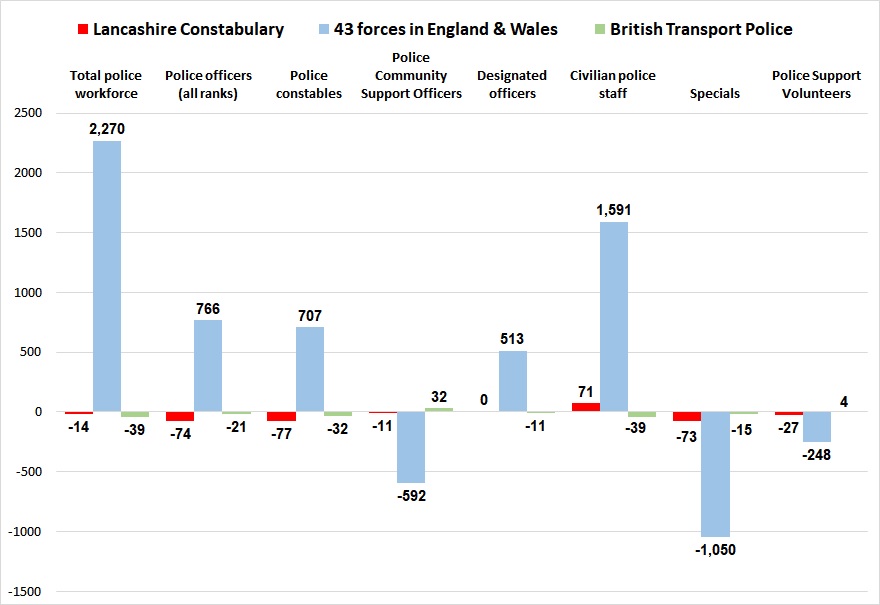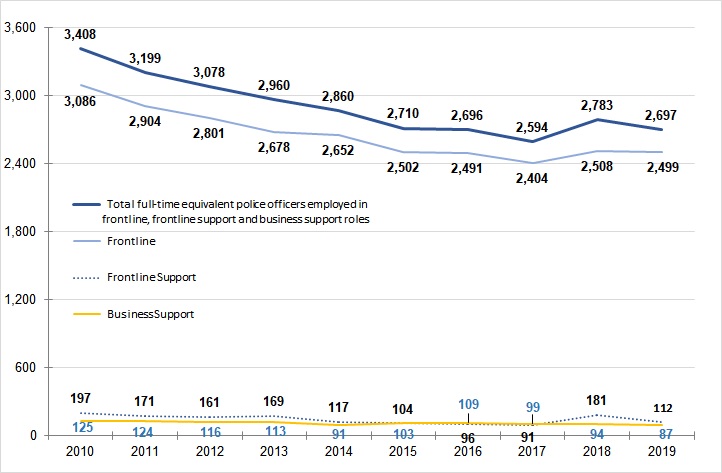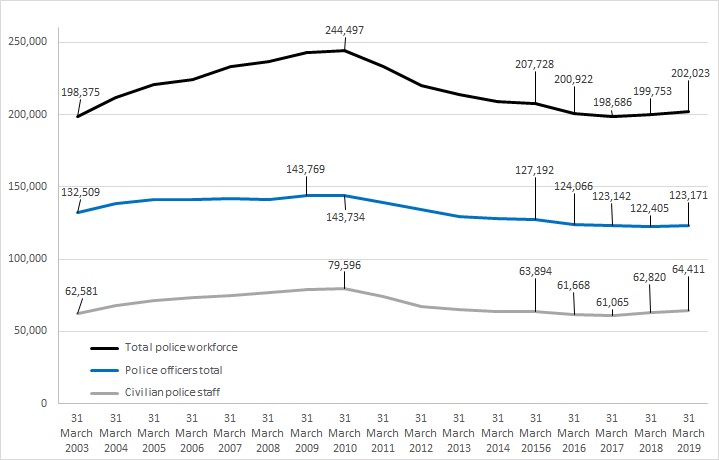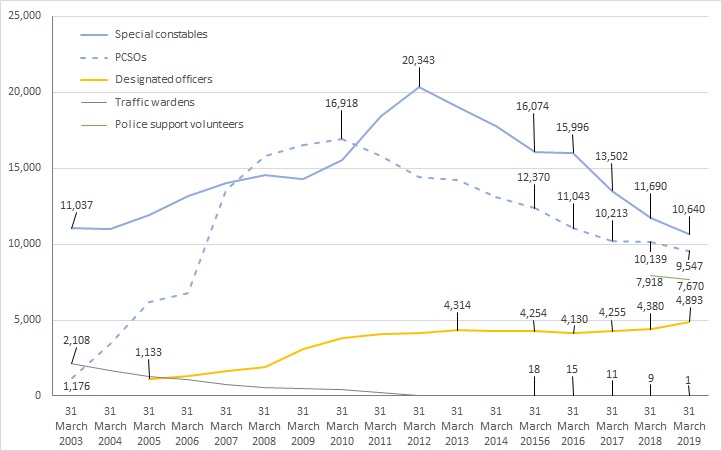Police workforce
Summary
The police workforce figures for Lancashire Constabulary as at 31 March 2019, show that there were 2,895 police officers of all ranks (full-time equivalents (FTEs)), plus 286 FTE police community support officers (PCSOs) and 1,822 civilian police staff (FTEs). There were also headcounts of 274 special constables and 343 police support volunteers (PSVs). This gives a total workforce of 5,003 FTEs, plus headcounts of 274 special constables and 343 PSVs. Special constables and police support volunteers do not have contracted working hours so their numbers are provided on a headcount rather than a FTE basis.
Lancashire Constabulary covers the Lancashire County Council 12-authority area, plus the two unitary authorities of Blackburn with Darwen and Blackpool. This is known as the Lancashire-14 area, which had an estimated resident population of 1.498 million people in mid-2018.
With 193 police officers per 100,000 population, the Lancashire Constabulary area has proportionately fewer officers per head than the England and Wales average of 208 as at 31 March 2019.
Of the 2,895 police officers (all ranks) within Lancashire constabulary on 31 March 2019, 144 (5%) were recorded as being long term absent (more than 28 working days). This includes sick leave, maternity/paternity leave, those suspended, employees taking a career break and 'other leave'. Other leave may include categories such a compassionate leave, study leave and special leave.
Yearly change in police workforce to 31 March 2019
The Lancashire Constabulary total FTE workforce of 5,003 as at 31 March 2019 was 14 less (-0.28%) than the figure of 5,017 a year earlier. For the 43 police forces in England and Wales, there were 202,023 FTE workers employed on the 31 March 2019, a rise of 2,270 (1.1%) on a year earlier. The British Transport Police employed an additional workforce of 4,546 FTEs (in England and Wales) on the 31 March 2019, which was 39 (0.9) lower than the 2018 total of 4,585 FTEs.
The number of police officers of all ranks in Lancashire Constabulary fell by 74 FTEs (-2.5%) over the year, from 2,969 at 31 March 2018, to 2,895 at 31 March 2019. Contrary to Lancashire Constabulary, for the 43 forces within England and Wales, the total number of police officers increased by 0.6%, or 766 FTEs, from 122,405 at 31 March 2018, to 123,171 FTEs at 31 March 2019. The British Transport Police, however, saw a decrease in the number of police officers of all ranks of 21 FTEs (-0.7%), falling from 2,865 FTEs on 31 March 2018, to 2,844 FTEs at 31 March 2019.
Looking at police constables in isolation, in Lancashire Constabulary, the number of constables fell by 77 FTEs (-3.3%) over the year, to 2,256 FTEs at 31 March 2019. Contrary to the Lancashire decrease, the number of police constables increased by 707 FTEs (0.7%) within England and Wales as a whole, to 96,070 FTEs on 31 March 2019. However, for the British Transport Police (in England and Wales), the number of police constables fell slightly, by 32 FTEs (-1.5%) over the year, to 2,170 FTEs on 31 March 2019.
With 151 police constables per 100,000 population, the Lancashire Constabulary area has proportionately fewer constables per head than the England and Wales average of 162 as at 31 March 2019.
Figure 1: Change in total police workforce and sub-categories of worker (full time equivalents) and change in the headcounts of special constables and police support volunteers –31 March 2018 to 31 March 2019

Source: GOV.UK, Home Office, Police workforce statistics, England and Wales: 31 March 2019 second edition and Police workforce, England and Wales: 31 March 2019 data tables second edition (Tables F1 to F6 updated). Worksheet tables H3 (police workforce), H4 (police officers), H10 (police support volunteers), H11 (police staff), H12 (police community support officers), H13 (designated officers) and H14 (special constables).
The Lancashire Constabulary civilian police staff totalled 1,822 FTEs at 31 March 2019. This was an increase of 71 FTEs (4.1%) on the figure of 1,751 for the previous year. For the 43 police forces within England and Wales as a whole, the police staff numbers increased by 2.5% (+1,591 FTEs) to 64,411 FTEs at 31 March 2019. The British Transport Police on the other hand saw a decrease in civilian staff of 39 FTEs (-2.7%), falling to 1,387 FTEs at 31 March 2019.
Police community support officer numbers decreased by 11 FTEs (-3.7%) within Lancashire Constabulary, from the 297 FTEs on the books at 31 March 2018, to the 286 in March 2019. For the 43 forces in England and Wales, the total number of PCSOs fell by 592 FTE posts (-5.8%) to 9,547 FTEs over the year. However, across the British Transport Police (in England and Wales), the number of PCSOs rose by 32 FTEs (12.0%), to 299 FTEs at 31 March 2019.
The headcount of special constables in Lancashire Constabulary decreased by 73 (-21.0%), or by more than a fifth, to 274 as at 31 March 2019, from the 347 recorded at 31 March 2018. For England and Wales as a whole, the headcount of special constables fell by 9.0% (-1,050) to 10,640 at the end of March 2019. In the British Transport Police, the number of special constables also reduced slightly, by 15 (-5.0%) to 287 on 31 March 2019.
The headcount of police support volunteers in Lancashire Constabulary decreased by 27 (-7.3%), to 343 as at 31 March 2019, from the revised figure of 370 recorded at 31 March 2018. Across the 43 forces in England and Wales, the headcount of PSVs fell by 3.1% (-248) to 7,670 at the end of March 2019, down from the revised headcount of 7,918 at March 2018. In the British Transport Police (in England and Wales), the number of PSVs rose slightly, by 4 (3.5%) to 119 on 31 March 2019.
The number of designated officers in Lancashire Constabulary was not available for both March 2018 and March 2019. For the remaining police forces within England and Wales that utilise designated officers, the number increased by 513 FTEs (11.7%) to 4,893 FTEs as at 31 March 2019. However, for the British Transport Police, the number of designated officers fell by 11 FTEs (-40.7%) to 16 FTEs at 31 March 2019.
Designated officers are police staff (who are not police officers) employed to exercise specific powers that would otherwise only be available to police officers. Designation can be to one or more of four roles: police community support officer (PCSO), investigation officer, detention officer and escort officer. For further information, please see the 'User Guide to Police Workforce Statistics' (18 July 2019 update).
Yearly change in frontline policing numbers and estimated change since 2010
Between 31 March 2018 and 31 March 2019, the total number of FTE police officers employed in all frontline, frontline support and business support roles within Lancashire Constabulary fell back by 85 FTEs (-3.1%), from 2,783 to 2,695 FTEs at 31 March 2019. The number of FTEs decreased in all three frontline categories in the Lancashire Constabulary area over the year. However, the majority of the reduction fell in the category for FTE police officers employed in frontline support roles (-69 FTEs, -38.1%).
This latest fall reversed the first increase in the series (since 2010) for Lancashire Constabulary, that took place the previous year, between 31 March 2017 and 31 March 2018, when the total number of FTE police officers employed in all frontline roles increased by 189 FTEs (7.3%), from 2,594 FTEs to 2,783 FTEs.
Despite the fall in numbers over the last year, the March 2019 figure for Lancashire Constabulary is 104 FTEs above the recent low point of 2,594 FTEs estimated for 31 March 2017.
The 31 March 2019 figure is still below the total of 3,408 FTEs estimated to be in all frontline, frontline support and business support roles within Lancashire Constabulary in March 2010 by 20.8% (-710 FTEs).
The yearly decrease in Lancashire Constabulary for all frontline roles (-3.1%, -85 FTEs) was greater than the reduction of -0.4% (- 446 FTEs) recorded for the 43 police forces in England and Wales, where numbers fell from 112,614 FTEs to 112,168 FTEs. See tables 5 and 6 in the full report below for further details.
Over the longer period, from March 2010 to March 2019, for the 43 police forces in England and Wales, the number of FTEs in all frontline, frontline support and business support roles is estimated to have fallen by -17.3% (- 23,385 FTEs) from 135,553 FTEs to 112,168 FTEs. The percentage reduction for Lancashire Constabulary (-20.8%) was higher between these dates.
Figure 2: Lancashire Constabulary - estimates of the number of full-time equivalent police officers employed in frontline, frontline support and business support roles, 31 March 2010 [1] to 31 March 2014 [1], and actual numbers from 31st March 2015 [2] to 31st March 2019 [2]

Notes: [1] Figures for March 2010 to March 2014 have been estimated based on data for a parallel running year (March 2015) and are rounded to the nearest whole number or 0.1 per cent. Further details can be found in the 'User Guide to Police Workforce Statistics'. [2] Figures from March 2015 to 2019 have been calculated using Her Majesty’s Inspectorate of Constabulary’s (HMIC’s) frontline policing model which can be found in Annex 4 of the Value for Money Profiles.[3] The frontline model excludes police officers recorded under the ‘Other’ function category, which includes police officers on maternity/paternity leave, career break, full-time education or on suspension; and those on long-term leave (sickness, compassionate special or unpaid). Some forces are not able to separate out employees on career breaks, maternity leave and other long term absence. Therefore in some cases these are not included in the “Other” category, but in the relevant function. [4] Visible operational frontline and non-visible frontline have been added together to give an overall frontline total.[5] Frontline support was previously named operational support under the old framework.
Source: GOV.UK, Home Office, Police workforce statistics. Police workforce, England and Wales, 31 March 2019: data tables – worksheet table F6.
Change in the total police workforce and police worker type within the 43 forces in England and Wales – 31 March 2003 to 31 March 2019
The following figures exclude the British Transport Police, which had a total workforce of 4,585 FTEs at 31 March 2018, plus headcounts of 302 special constables and 115 police support volunteers.
Change in the total police workforce
Figure 4 shows that the total police workforce employed in the 43 police forces in England and Wales has fallen by 44,745 FTEs (-18.3%), or more than a sixth, between 31 March 2010 and 31 March 2018 from 244,497 to 199,752 FTEs.
The total police workforce has increased slightly since March 2017, rising by 3,337 FTEs (1.7%) from 198,686 FTEs, to 202,023 FTEs in March 2019.
The latest yearly rise was mainly due to an increase in the number of civilian police staff and those referred to as "designated officers" (who have limited powers designated to them by a chief constable). These latest figures also include the first increase in police officers since 2009 (+766 FTEs (+0.6%)).
Figure 4: Change in total police workforce, police officers and civilian police staff within the 43 forces in England and Wales from 31 March 2003 to 31 March 2019

Notes: [1] Total police workforce excludes British Transport Police. [2] Total police workforce excludes special constables and secondments to central services, but includes secondments in to forces, and workers on career breaks. [3] Total police workforce - data initially provided by the Metropolitan Police as at 31 March 2015 excluded workers on career breaks, and included those seconded out of the force. These figures have subsequently been revised to bring them in line with data for other forces and years.
Source: GOV.UK, Home Office, Police workforce statistics. Police workforce, England and Wales, 31 March 2019: data tables second edition – worksheet table H3.
Change in the number of police officers
The number of police officers has decreased by -20,598 FTEs (-14.3%), or a seventh, between 31 March 2009 and 31 March 2019 in the 43 police forces in England and Wales, from 143,769 to 123,171 FTEs. Not all of these officers will be available for duty. Police officers made up the largest proportion of paid police workers as at 31 March 2019, at just over three fifths (61.0%).
The total number of police officers has increased slightly since March 2018, rising by 766 FTEs (0.6%) from 122,405 FTEs to 123,171 FTEs, in March 2019. This was the first increase in police officers since 2009.
Change in the number of PCSOs
The number of PCSOs within the 43 police forces in England and Wales has decreased by 7,371 FTEs (-43.6%), from the peak of 16,918 FTEs at 31 March 2010, to 9,547 at 31 March 2019. As at 31 March 2019, PCSOs accounted for 4.7% of the total police workforce.
Change in the number of civilian police staff
The civilian police staff in the 43 police forces in England and Wales has reduced by -15,185 FTEs (-19.1%) or almost a fifth, between 31 March 2010 and 31 March 2019, from 79,596 to 64,411 FTEs. Civilian police staff accounted for 31.9% of the total police workforce at 31 March 2019, or just under a third. However, the number of civilian police staff has increased slightly since March 2017, rising by 3,346 FTEs (5.5%) from 61,065 FTEs to 64,411 FTEs, in March 2019.
Change in the headcount of special constables
Figure 5 reveals that he headcount of special constables peaked at 20,343 at 31 March 2012 within the 43 police forces in England and Wales, but has since reduced by -9,703 (-47.7%) or almost a half, to 10,640 by 31 March 2019.
Change in the headcount of police support volunteers
In 2018, a new category was included in the police workforce statistics that provides the headcount of police support volunteers (PSVs).
The headcount of PSVs within the 43 police forces in England and Wales has decreased by 248 (-3.1%) to 7,670 at 31 March 2019, down from the initial revised headcount of 7,918 at 31 March 2018.
Change in the number of designated officers
The number of designated officers in the 43 police forces in England and Wales increased by 513 FTEs (11.7%) from 4,380 FTEs at 31 March 2018, to a new peak of 4,893 FTEs at 31 March 2019. Designated officers represented 2.4% of the total police workforce at 31 March 2019.
Figure 5: Change in the number of special constables, police community support officers (PCSOs), designated officers and traffic wardens within the 43 forces in England and Wales from 31 March 2003 to 31 March 2019

Notes: [1] Some forces are unable to provide data on some types of designated officers separately. In these cases, designated officers have been counted under police staff. [2] Figures for special constables and police support volunteers are provided on a headcount basis. [3] Data initially provided by the Metropolitan Police as at 31 March 2015 excluded workers on career breaks, and included those seconded out of the force. These figures have subsequently been revised to bring them in line with data for other forces and years.
Source: GOV.UK, Home Office, Police workforce statistics. Police workforce, England and Wales, 31 March 2019: data tables second edition – worksheet table H3.
Change in the number of traffic wardens
There was just one traffic warden recorded in the 43 police forces on 31 March 2019. This low figure for traffic wardens reflects the dominant role of local authorities in parking control. Numbers have reduced by 99.95% from the 2,108 recorded at 31 March 2003.
Further information and analysis
The way that the Home Office records the various categories of functions undertaken by the police workforce changed with the data published in July 2016. The model used to measure frontline policing has also changed. The full report, which can be downloaded via the link below, provides further information on the changes as well as data tables, additional background information, yearly change in Lancashire constabulary frontline policing numbers and links to relevant web sites.
Further analysisPolice workforce in the Lancashire Constabulary (Lancashire-14) area, 31 March 2019 (PDF 1,106 KB) |
Page updated 12 June 2020